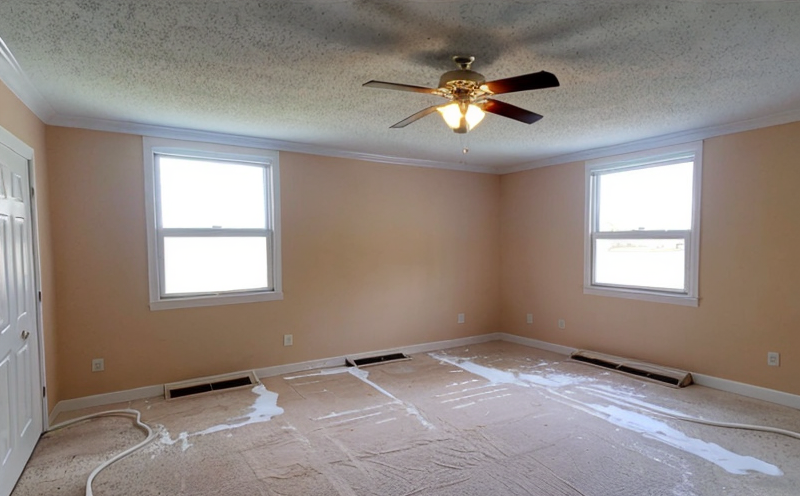ASTM D573 Heat Aging Testing of Rubber Materials
The ASTM D573 standard specifies a heat aging test method suitable for determining the resistance to thermal aging of rubber materials. This testing is essential in industries where rubber components are subject to prolonged exposure to elevated temperatures, such as automotive, aerospace, and construction sectors.
Rubber materials undergo significant changes when exposed to high temperatures. The purpose of ASTM D573 heat aging testing is to evaluate the physical properties and chemical stability of these materials over time under controlled temperature conditions. The test helps in ensuring that rubber parts maintain their performance characteristics, especially in critical applications like seals, hoses, and tires.
The methodology involves exposing specimens to a specified temperature for a predetermined period. Specimens are typically small pieces cut from larger rubber components. After the aging process, physical tests are conducted to measure changes such as tensile strength, elongation at break, hardness, and appearance. The results of these tests provide insights into the durability and reliability of the rubber materials under heat stress.
The ASTM D573 test is applicable to various types of rubber materials including natural, synthetic rubbers, and blends thereof. It also covers vulcanized rubber products that are intended for use in applications where thermal stability is crucial. The standard ensures consistency across different laboratories by providing detailed guidelines on specimen preparation, testing conditions, and evaluation criteria.
One of the key aspects of ASTM D573 testing is understanding the impact of temperature on rubber materials. Higher temperatures can lead to cross-linking reactions which harden the material, reduce flexibility, and decrease tensile strength. Conversely, excessively low temperatures might cause brittleness and cracking. By conducting heat aging tests according to ASTM D573, manufacturers can identify optimal processing conditions that balance mechanical properties with thermal stability.
The test procedure outlined in ASTM D573 involves placing rubber specimens into a controlled environment chamber where they are maintained at specified temperatures for extended durations. For instance, the standard may specify exposure times ranging from 48 hours to several weeks depending on the intended application of the rubber component. During this period, it is crucial that environmental parameters like humidity and airflow remain constant to avoid influencing test results.
After the prescribed time has elapsed, the rubber specimens are removed from the chamber and evaluated for changes in their physical properties. Tensile tests measure how much force the material can withstand before breaking. Elongation at break indicates the degree of stretchability retained by the rubber after aging. Hardness measurements reflect any softening or hardening that occurred during exposure to heat.
The appearance of the specimen is also assessed visually for signs of discoloration, cracking, or other deformations indicative of thermal degradation. These visual inspections complement quantitative assessments provided by mechanical tests mentioned earlier. By combining both qualitative and quantitative data from various tests, researchers gain comprehensive understanding about how specific rubber compounds behave under heat aging conditions.
ASTM D573 heat aging testing plays a vital role in quality assurance programs aimed at enhancing product longevity and safety across diverse industries utilizing rubber components. Compliance with this standard ensures consistent performance standards among manufacturers worldwide while fostering innovation through rigorous evaluation practices.
Benefits
- Enhanced Product Durability: Ensures that rubber materials maintain their structural integrity and mechanical properties even after prolonged exposure to high temperatures.
- Improved Safety Standards: Helps in identifying potential weaknesses early on, thereby preventing accidents caused by compromised rubber parts.
- Informed Decision-Making: Provides valuable data that guides decisions regarding material selection and manufacturing processes.
- Regulatory Compliance: Facilitates adherence to international standards like ASTM D573, ensuring compliance with regulatory requirements for product safety and performance.
The benefits extend beyond mere testing; they encompass improved overall quality control measures leading to enhanced customer satisfaction and reduced warranty claims. By leveraging the insights gained from ASTM D573 heat aging tests, companies can develop more robust products capable of withstanding harsh environmental conditions.
Eurolab Advantages
At Eurolab, we pride ourselves on offering comprehensive testing services tailored specifically for the additive manufacturing and 3D printing sectors. Our expertise lies not only in conducting precise ASTM D573 heat aging tests but also ensuring accurate interpretation of results to guide informed decision-making processes.
We employ state-of-the-art facilities equipped with advanced instruments capable of delivering reliable data across a wide range of temperature conditions. This allows us to provide consistent and reproducible test results that meet stringent quality standards set forth by industry leaders. Our skilled technicians are well-versed in handling complex rubber samples, ensuring accurate specimen preparation according to ASTM D573 guidelines.
Moreover, Eurolab’s commitment extends beyond just executing tests; we offer consultative services aimed at helping clients optimize their product designs based on test outcomes. Through our experienced team of engineers and scientists, we ensure that every step from sample preparation through final analysis aligns perfectly with client objectives. Whether you are a small startup or an established corporation, Eurolab stands ready to support your needs with unparalleled precision and reliability.
Quality and Reliability Assurance
At Eurolab, we prioritize quality and reliability assurance in all our services. Our commitment to excellence is reflected in the precision and accuracy of our ASTM D573 heat aging tests. By adhering strictly to industry standards, we ensure that every test conducted meets the highest level of integrity.
- Consistent Results: Utilizing standardized protocols ensures consistent outcomes, enabling accurate comparisons between different batches or versions of rubber materials.
- Compliance Verification: Our rigorous testing process verifies compliance with relevant international standards like ASTM D573, ensuring that products meet stringent safety and performance criteria.
- Data Accuracy: Advanced instrumentation and meticulous attention to detail guarantee precise measurement of physical properties affected by heat aging.
Our unwavering dedication to quality control is further bolstered by regular calibration of equipment and continuous training for our personnel. This commitment ensures that we consistently deliver reliable test results, fostering trust among our clients.





